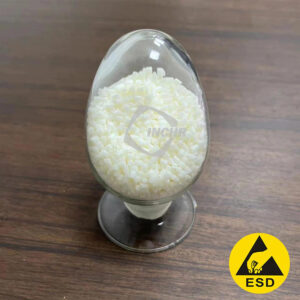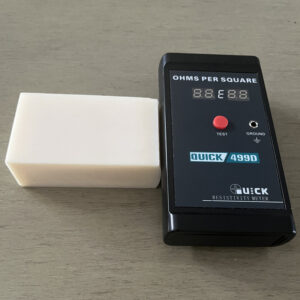ESD POM(ESD Delrin) is a copolymer with an permanent anti-static agent added to POM resin. It has good conductivity and long-term static dissipation properties and is widely used in the electronics, electrical, aviation, and automotive industries. Its surface resistivity ranges from 10^6 to 10^9 Ohms. The compound is divided into natural and black colors, which can achieve anti-static, static dissipation, conductivity, and electromagnetic interference (EMI) shielding functions.

The main processing methods of ESD POM (ESD Delrin) raw materials include injection molding and extrusion.
Injection molding process of ESD POM | Product Catalog
- Plastic treatment: ESD POM (ESD Delrin) has water absorption 0.2%-0.5%. regular POM can be processed without drying, but ESD POM must be dried. The drying temperature should be above 80℃and the drying time should be more than 2 hours.
- Selection of molding machine: ESD POM has no special requirements for the injection molding machine except that the screw must have no stagnant area. General injection molding is sufficient.
- Mold and gate design: Common mold temperature control is 80-90°C, runner diameter is 3-6mm, gate length is 0.5mm, gate size depends on the thickness of the plastic wall, circular gate diameter is at least It should be 0.5-0.6 times the thickness of the product. The width of the rectangular gate is usually 2 times or more the thickness, the depth is 0.6 times the wall thickness, and the demoulding slope is between 40′-130′.
- Process parameter setting: The melting temperature of ESD POM can be set to 195-205℃. The injection speed is generally medium-fast. Too slow is prone to ripples, and too fast is prone to spray marks and shear overheating. The lower the back pressure, the better, generally not more than 200 bar. The holding time is usually 30% of the total cycle time to ensure stable molding weight.
Extrusion molding process of ESD POM
- ESD POM (ESD Delrin) compounds are extruded at high temperatures through an extruder and then extruded through the corresponding die opening to obtain sheets of different thicknesses. It is processed into different jigs according to drawing requirements and applied to mobile phone assembly and electronic product assembly lines to prevent damage to electronic components caused by static electricity.
- Raw material selection: Select POM resin suitable for extrusion and with antistatic properties, which is required to have high molecular weight, low impurity content, and good processing performance. ESD POM has a certain degree of hygroscopicity and needs to be dried to control the moisture content at a low level, such as below 0.1%, to prevent moisture from causing defects such as bubbles and silver streaks during processing, affecting antistatic properties and product quality.
- Extruder selection: According to product output and quality requirements, select a single-screw or twin-screw extruder of appropriate specifications and models. Twin-screw extruders have good mixing effects and are more conducive to the dispersion of antistatic agents.
- Process parameter setting: The temperature of each section of the barrel is generally set to 180-210℃, and the specific temperature is adjusted according to the antistatic POM brand and antistatic agent characteristics. The head temperature is slightly lower than the barrel end temperature by 5-10℃ to prevent the material from overheating and decomposing at the head or solidifying prematurely. The screw speed is usually controlled at 50-150 rpm. If the speed is too low, the material will not be fully plasticized and the antistatic agent will be unevenly dispersed. If the speed is too high, the material may be sheared and overheated, affecting the antistatic performance and product quality. Maintain an appropriate extrusion pressure, generally 5-20 MPa. According to the extrusion speed and product size requirements, reasonably adjust the traction speed, usually 1-5 meters/minute, so that the extruded product will not deform or break during the traction process, ensuring the product size accuracy and appearance quality.

Properties and advantages of ESD POM
- High strength and hardness: Excellent wear resistance and high mechanical strength, and maintains these properties over a wide temperature range;
- Chemical resistance: ESD POM(ESD Delrin) materials are resistant to many corrosive chemicals, such as acids, alkalis, and organic substances;
- Excellent insulation properties: The materials have good insulation properties against electricity and heat;
- Excellent processing performance: ESD POM(ESD Delrin) materials are easy to form and process, and parts of various shapes can be manufactured through injection molding, extrusion molding, calendering, and other methods;
- Good environmental adaptability: The materials have strong adaptability to changes in the external environment and can maintain their physical properties and shape and dimensional stability even in high temperature, high humidity, and low-temperature environments.
INCHR@ESD POM(ESD Delrin) compounds have excellent comprehensive properties and are one of the varieties of plastic raw materials whose mechanical properties are closest to metals. Its tensile strength, bending strength, fatigue strength, wear resistance and electrical properties are all very good, and it is used in many fields. Has a wide range of applications.




